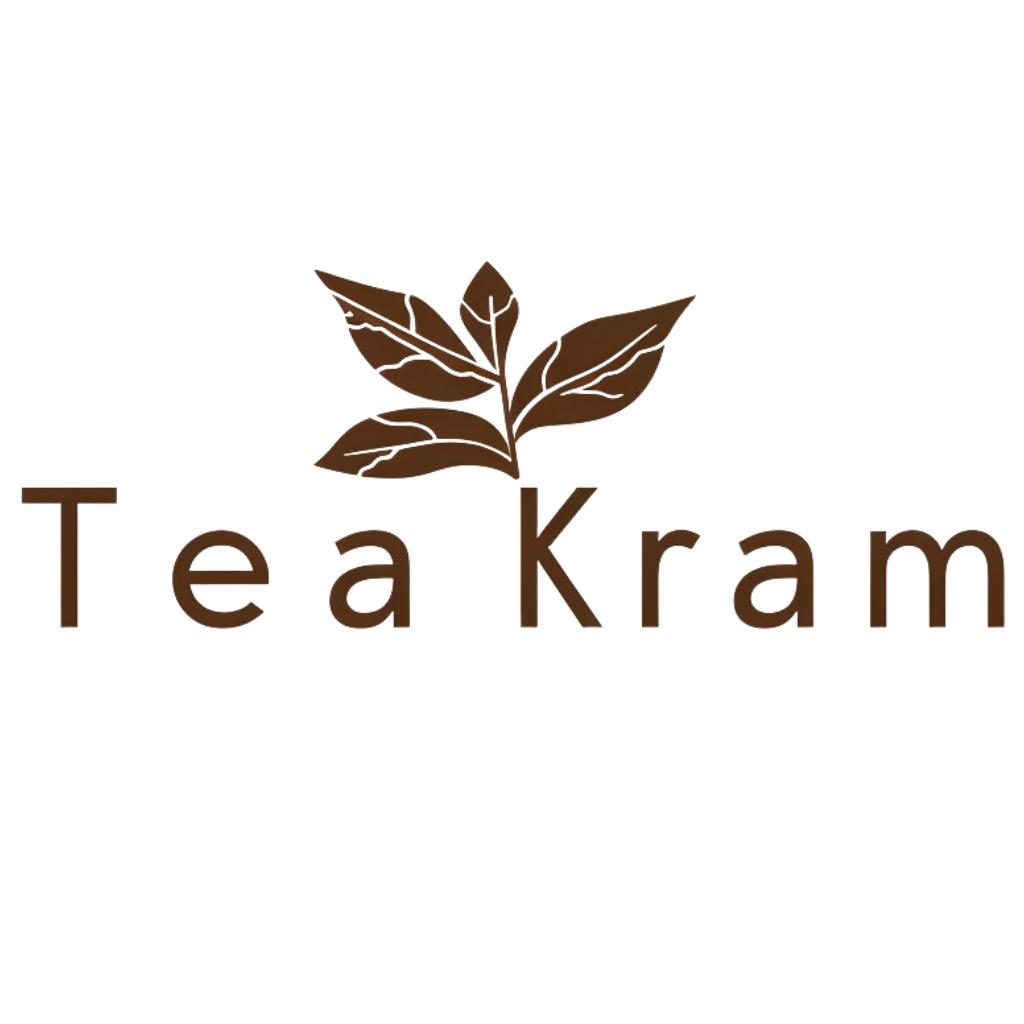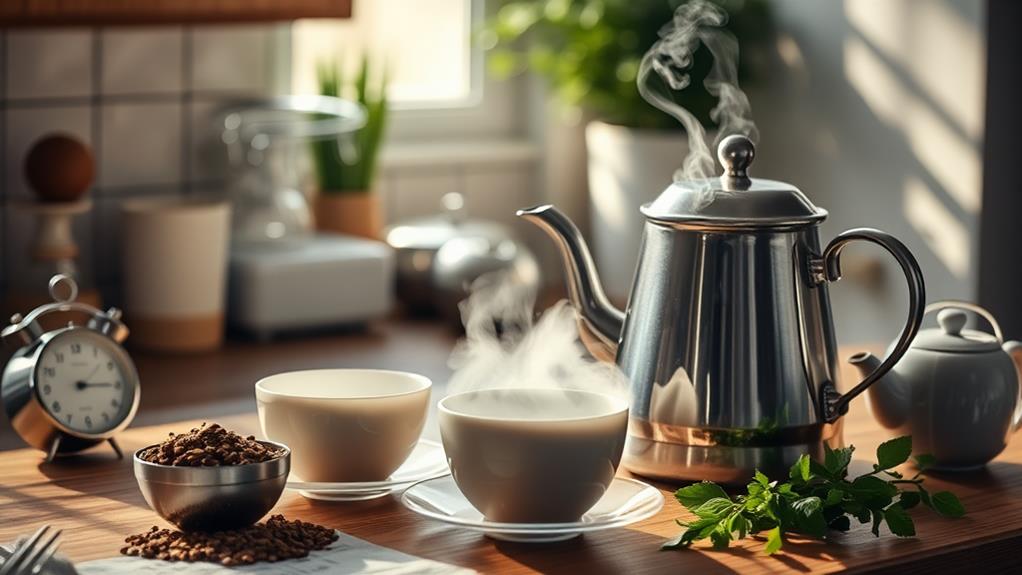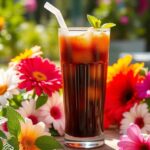Making the perfect cup of tea every time is easier than you think! Start by choosing your favorite type, like black for a bold kick or herbal for something relaxing. Measure your tea to about one teaspoon per 6-8 ounces of water. Use filtered water, and remember, temperatures matter—a hot 200°F for black tea, gentler for green at 160°F to 180°F. Steep times are crucial: 3-5 minutes for black, 2-3 for green. Don't forget to add fun flavors like cinnamon or mint! With these tips, you'll brew a delightful cup that warms your day. There's plenty more to explore!
Choosing the Right Tea
When selecting the right tea, it's essential to consider your personal taste preferences and the desired experience. You might love the bold, robust flavor of black tea or prefer the refreshing notes of green tea. Each type offers unique health benefits, like antioxidants in green tea, which can boost your immune system.
Additionally, exploring the cultural significance of tea can deepen your appreciation for your selection, as each variety is steeped in tradition and history.
Don't forget about herbal teas, which are caffeine-free and packed with various health benefits, from calming chamomile to invigorating peppermint. When you choose a tea, think about what you want it to do for you. Are you looking for relaxation, energy, or maybe a little boost in focus?
Cultural significance also plays a big role in tea selection. Each type of tea carries a story, whether it's the rich traditions of Japanese matcha ceremonies or the vibrant tea culture of India.
Understanding these backgrounds not only enhances your tea experience but also connects you to a larger community of tea lovers. So go ahead, explore different varieties, and find the one that resonates with you. Your perfect cup of tea awaits, and it's just a choice away!
Measuring Tea and Water
Getting the measurements right for tea and water is crucial for brewing the perfect cup. When you're experimenting with different tea types, precise measurements can elevate your experience. Too much tea can make it bitter, while too little leaves it weak.
Here's a quick reference table to guide you:
| Tea Type | Tea per Cup (grams) | Water per Cup (ml) |
|---|---|---|
| Black Tea | 2-3 | 240 |
| Green Tea | 1-2 | 240 |
| Herbal Tea | 2-4 | 240 |
| Oolong Tea | 2-3 | 240 |
| White Tea | 2-3 | 240 |
Water quality plays a significant role too. Using filtered or spring water enhances the flavor of your chosen tea. Tap water can sometimes contain chemicals that alter the taste. So, make sure you're using the best water available to you!
Water Temperature Matters
When it comes to brewing the perfect cup of tea, water temperature plays a big role in how your drink tastes.
Different types of tea require specific temperatures to unlock their best flavors, so knowing these can really enhance your experience.
Let's explore the ideal brewing temperatures and how they impact the flavor profile of your favorite teas!
Ideal Brewing Temperatures
Although many people overlook it, the temperature of your water plays a crucial role in brewing the perfect cup of tea. Different types of tea thrive at specific temperature variations, making this an essential aspect of your brewing equipment. For black tea, aim for water around 200°F, while green and white teas prefer a gentler 160°F to 180°F. Herbal infusions can handle boiling water at about 212°F, unlocking their vibrant flavors.
Investing in quality tea accessories, like a thermometer or temperature-controlled kettle, can elevate your steeping techniques. Understanding how these temperatures affect flavor combinations can enhance your tea experience, drawing inspiration from diverse tea cultures around the world.
You'll be amazed at how much a simple temperature adjustment can transform your brew!
Don't forget about serving suggestions! Experiment with different temperatures to discover your perfect cup, whether you enjoy a delicate green tea or a robust black tea. By paying attention to water temperature, you'll unlock the full potential of your tea, creating a delightful and innovative experience every time you brew.
Impact on Flavor Profile
The right water temperature can significantly alter the flavor profile of your tea, transforming an ordinary brew into an extraordinary experience. When you brew tea, the water temperature affects the extraction of flavor compounds, enhancing or dulling the aroma profile and overall taste. Different tea origins have unique characteristics that respond to specific temperatures, making this an essential factor in your steeping techniques.
Here's a quick guide to help you understand how water temperature impacts your tea:
| Water Temperature | Tea Type | Flavor Outcome |
|---|---|---|
| 160°F – 185°F | Green Tea | Grassy, delicate |
| 190°F – 205°F | Black Tea | Bold, robust |
| 200°F – 212°F | Herbal Tea | Rich, full-bodied |
Keep in mind that infusion time also plays a role in flavor. Pair the right temperature with your taste preferences, and don't forget about water quality; it can make or break your brew. By mastering these elements, you'll unlock the full potential of your tea's flavor characteristics, enhancing your overall experience!
Brewing Time Essentials
Perfecting your tea requires more than just quality leaves; it hinges on the crucial element of brewing time. Knowing how long to steep your tea can elevate your beverage from ordinary to extraordinary. Different types of tea demand unique brewing times, so it's essential to explore various tea brewing techniques.
For instance, black tea typically thrives with a steeping time of 3 to 5 minutes, while green tea prefers a shorter window of 2 to 3 minutes. Oversteeping can lead to bitterness, and nobody wants that!
When it comes to herbal infusion methods, things get even more interesting. Herbal teas often benefit from longer steeping times, usually around 5 to 7 minutes. This allows the flavors and nutrients to fully release, creating a delightful cup.
Experimenting with timing can be a fun way to discover your perfect brew. Maybe you'll find that you enjoy a slightly stronger flavor, or perhaps a lighter touch is more your style.
Whatever your preference, keep a timer handy, and don't be afraid to play around with different times. You'll soon be brewing tea like a pro!
Enhancing Flavor With Additives
Many tea enthusiasts find that adding certain ingredients can elevate their brew to new heights.
If you're looking to innovate your tea experience, consider experimenting with spice blends and herbal infusions. These can transform your cup into something truly special!
Here are three exciting additives to try:
- Cinnamon: A sprinkle of this warm spice can add a comforting sweetness that pairs beautifully with black tea.
- Ginger: Fresh or powdered, ginger gives your tea a zesty kick, perfect for both flavor and health benefits.
- Mint: A few fresh mint leaves can refresh your cup, making it a delightful choice on hot days.
Straining Your Tea
When it comes to straining your tea, the right tools and timing can make all the difference.
You'll want to choose a strainer that suits your brewing method, whether it's a fine mesh, a tea infuser, or a simple sieve.
Plus, cleaning your equipment afterward is essential to keep your tea tasting fresh for the next cup!
Choosing the Right Strainer
Choosing the right strainer can significantly enhance your tea-drinking experience. The right choice not only impacts the flavor but also adds a touch of elegance to your brewing ritual. Here are three things to consider when selecting a strainer:
- Material Matters: Stainless steel mesh strainers offer durability factors that stand the test of time. They're perfect for both loose leaf teas and herbal infusions, ensuring fine mesh quality for optimal flavor retention.
- Ease of Use: Look for strainers that are easy to clean and handle. A well-designed strainer can make the difference between a delightful tea experience and a messy one, especially when you're in a hurry!
- Aesthetic Appeal: Don't underestimate the visual impact of your tea-making tools. A beautiful strainer can elevate your kitchen and add charm to your tea time.
Whether you're brewing bagged tea or exploring exotic loose leaf options, investing in the right strainer is essential.
Embrace innovation in your tea game, and you'll not only savor every sip but also enjoy the process. Happy brewing!
Timing Your Strain
How do you know the perfect moment to strain your tea? Timing is crucial in brewing techniques, as over-steeping can lead to bitterness. You want to strike that balance for a delightful experience. The type of tea you use can affect the steeping time, so pay attention!
Here's a handy table to help you gauge when to strain your tea based on the type:
| Type of Tea | Steeping Time | Flavor Profile |
|---|---|---|
| Green Tea | 2-3 minutes | Fresh, grassy, and vibrant |
| Black Tea | 3-5 minutes | Bold, robust, and malty |
| Herbal Tea | 5-7 minutes | Fruity, floral, and soothing |
| Oolong Tea | 4-6 minutes | Complex, fruity, and floral |
| White Tea | 4-5 minutes | Delicate, sweet, and light |
Using quality tea strainers can enhance your brewing experience. As you master your timing, you'll discover the unique flavors and aromas each type of tea offers. So, keep experimenting, and soon you'll be straining like a pro! Enjoy every sip of your perfectly brewed cup!
Cleaning Your Equipment
After enjoying your perfect cup of tea, it's essential to give your strainer a thorough cleaning to maintain its performance and longevity.
Neglecting this step can lead to residue build-up, affecting the taste of your future brews.
Here are three simple yet effective cleaning techniques to keep your equipment in top shape:
1. Rinse Immediately: Right after straining, rinse your strainer under warm water to remove any loose tea leaves.
This quick action prevents stubborn stains from forming.
2. Soak Regularly: For deeper cleans, soak your strainer in a mixture of warm water and a few drops of dish soap for about 15 minutes.
This helps break down any oils and particles that cling stubbornly.
3. Use a Brush: A soft-bristled brush can be a game-changer.
Gently scrub the mesh or holes to dislodge any remaining debris, ensuring your strainer is spotless.
The Perfect Tea-to-Water Ratio
Finding the right tea-to-water ratio is key to brewing a delicious cup of tea. You'll want to experiment a bit to discover what suits your taste, but a general guideline is one teaspoon of loose tea or one tea bag for every six to eight ounces of water. This ratio helps achieve a perfect flavor balance, ensuring your cup isn't too strong or too weak.
If you prefer a bolder tea strength, simply increase the amount of tea you use. Maybe try one and a half teaspoons for a more robust flavor. Conversely, if you want a lighter brew, decrease the tea to half a teaspoon.
Remember, the type of tea also plays a role; delicate white teas may require less, while hearty black teas can handle more.
Don't shy away from adjusting based on your mood, the time of day, or the season! It's all about finding that sweet spot that excites your taste buds.
With a little practice, you'll be brewing the perfect cup every time, impressing friends and family with your newfound tea expertise. So, grab your kettle and get experimenting!
Storing Leftover Tea
Leftover tea can be a delightful treat if stored properly. You don't have to waste that perfectly brewed cup! With the right tea storage methods, you can enjoy your tea later or even turn it into something new.
Here are three innovative ideas for using your leftover tea:
- Iced Tea Magic: Refrigerate your leftover tea, and when you're ready, pour it over ice for a refreshing drink. Add a splash of lemon or a hint of mint for an extra zing!
- Flavorful Cooking: Use leftover tea as a cooking liquid for grains like rice or quinoa. It infuses them with a unique flavor and elevates your meals.
- Creative Cocktails: Mix your chilled tea with spirits for a delightful cocktail. Think tea-infused mojitos or a soothing gin and tea blend!
Exploring Different Tea Varieties
If you've enjoyed experimenting with leftover tea, you might be curious about the wide range of tea varieties available. The world of tea is incredibly diverse, and exploring different types can elevate your tea experience.
Start with black teas, known for their robust flavors, perfect for a morning pick-me-up. If you're looking for something lighter, green teas offer a refreshing taste, packed with antioxidants.
White teas, the most delicate of all, provide a subtle sweetness that's perfect for a quiet afternoon. Don't overlook oolong varieties, which blend the richness of black tea with the freshness of green.
If you're in the mood for something spiced, chai blends combine black tea with aromatic spices, creating a cozy, warming cup. Herbal teas are fantastic for those seeking caffeine-free options, featuring an array of flavors from chamomile to peppermint.
For a fruity twist, try fruit infusions that burst with vibrant flavors. Lastly, flavored teas, like vanilla or jasmine, can add an exciting twist to your routine. With each of these varieties, you're sure to find a favorite that inspires your next tea adventure!
FAQ
Can I Reuse Tea Leaves for Multiple Brews?
Yes, you can definitely reuse tea leaves! Experiment with different brewing techniques to extract unique flavors. Just remember, the number of brews depends on the type of tea—high-quality leaves often yield the best results.
How Long Can I Store Loose Tea Leaves?
You'll love how long you can store loose tea leaves! With proper tea storage tips, they can last up to a year. Look for freshness indicators like aroma and color to ensure optimal flavor.
What Types of Water Are Best for Brewing Tea?
For brewing tea, use filtered water with balanced mineral content. The ideal water temperature varies by tea type, enhancing flavors and aromas. Experiment with different waters to discover innovative combinations that elevate your tea experience.
Does the Type of Cup Affect Tea Flavor?
Your cup's material can dramatically alter flavor nuances, making it feel like a completely different tea experience. Porcelain and glass enhance subtle notes, while metal might mask them—choose wisely to elevate your brew!
Can I Drink Tea Cold or Iced?
Absolutely, you can enjoy tea cold or iced! Cold brew techniques enhance flavor and reduce bitterness. Plus, iced tea benefits include hydration and antioxidants, making it an innovative choice for refreshing, flavorful drinks.
Final Thoughts
Now that you know how to make the perfect cup of tea, it's like having a golden ticket to a cozy moment. By choosing the right tea, measuring precisely, and paying attention to water temperature and brewing time, you can elevate your tea experience. Don't forget to explore different varieties and enhance flavors with your favorite additives. So, steep away and enjoy your delightful cup of tea—every sip should feel like a warm hug!



